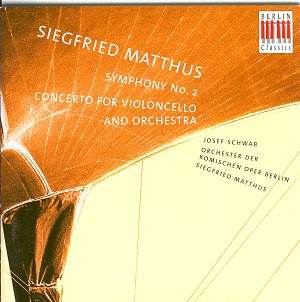 Composer: Siegfried Matthus
Composer: Siegfried Matthus
Works: Cello Concerto (1975), Symphony No. 2 (1976)
Performers: Josef Schwab (cello), Orchester der Komische Oper Berlin, conducted by Siegfried Matthus
Recording: SRK Berlin, September 1978
Label: Berlin Classics 0094522 BC
Siegfried Matthus, a significant figure in 20th-century German music, presents a compelling portrait of human emotion and existential contemplation in his works, particularly the Cello Concerto and Symphony No. 2. Composed during a period of rich experimentation in modern classical music, Matthus’s compositions reflect a blend of expressionist sentimentality and structural rigor, drawing on influences from earlier composers while forging a distinct voice. The Cello Concerto, written in 1975, is an ambitious three-movement work that unfolds seamlessly, enveloping the listener in its emotional depth and technical complexity.
The performance of the Cello Concerto is marked by its intertwining of lyrical and intense moments, as articulated by cellist Josef Schwab. His playing oscillates between declamatory passages and lyrical lines, creating an emotional landscape that mirrors the concerto’s turbulent character. The opening movement, characterized by its unsettling brass gestures, establishes a sense of urgency that is maintained throughout. Schwab’s command of the instrument shines particularly in the beautifully rendered cantabile section, where his phrasing breathes life into Matthus’s intricate scoring for cello and strings. This moment serves as a respite amidst the otherwise anguished discourse of the movement, showcasing both the technical prowess and emotive quality of the solo part.
The second movement, Lento, offers a tranquil contrast, enveloping the listener in a delicate dreamscape. Here, Matthus’s scoring is exquisite, with intricate textures that evoke an ethereal quality. Schwab’s interpretation is both sensitive and nuanced, allowing the melodic line to unfurl organically. However, the movement’s tranquility is periodically disrupted by more agitated episodes, which Schwab navigates with remarkable agility, effectively capturing the underlying tension that permeates the work. This duality of serenity and turbulence is a testament to Matthus’s compositional skill and Schwab’s interpretive acumen.
The final Prestissimo bursts forth with a frenetic energy, a nervous rondo that propels the work toward its conclusion. The orchestral writing in this movement is particularly striking, with Matthus employing a variety of timbres to create a sense of urgency that culminates in a powerful orchestral glissando—a stark final statement that eschews triumph in favor of ambiguity. The conductor, Siegfried Matthus himself, imbues the performance with a clear understanding of the score, ensuring that the orchestral forces respond dynamically to Schwab’s playing. The balance between soloist and ensemble is well achieved, allowing the intricate interplay to resonate throughout.
Matthus’s Symphony No. 2, recorded concurrently, shares thematic and stylistic similarities with the Cello Concerto, employing a four-movement structure that emphasizes unity through its continuous flow. The opening Sostenuto begins tentatively, establishing a mood of uncertainty that pervades much of the symphony. The orchestration is rich and varied, particularly in the Scherzo, where Matthus juxtaposes nervous fanfares with more introspective material. The Lento movement recalls the lyrical qualities of the Cello Concerto, and its nocturnal ambiance is enhanced by the delicate scoring, reminiscent of a twilight reverie. The final movement, while brimming with momentum, concludes on a questioning note, much like its predecessor.
Technical aspects of the recording are commendable, with sound quality that remains vibrant despite the passage of time. The engineering captures the nuances of both soloist and orchestra, facilitating a clear dialogue between them. This recording stands out not only for its interpretive insights but also for its fidelity to the composer’s intentions.
Matthus’s Cello Concerto and Symphony No. 2 deserve greater recognition in the contemporary repertoire. They exemplify a deeply honest and communicative approach to composition, characterized by emotional depth and structural coherence. The performances, particularly Schwab’s eloquent cello work and Matthus’s insightful conducting, illuminate the richness of these works, inviting both musicians and audiences to explore the expressive possibilities inherent in Matthus’s music. As the landscape of 20th-century classical music continues to be re-evaluated, these compositions affirm their place as compelling contributions that merit further exploration and performance.



